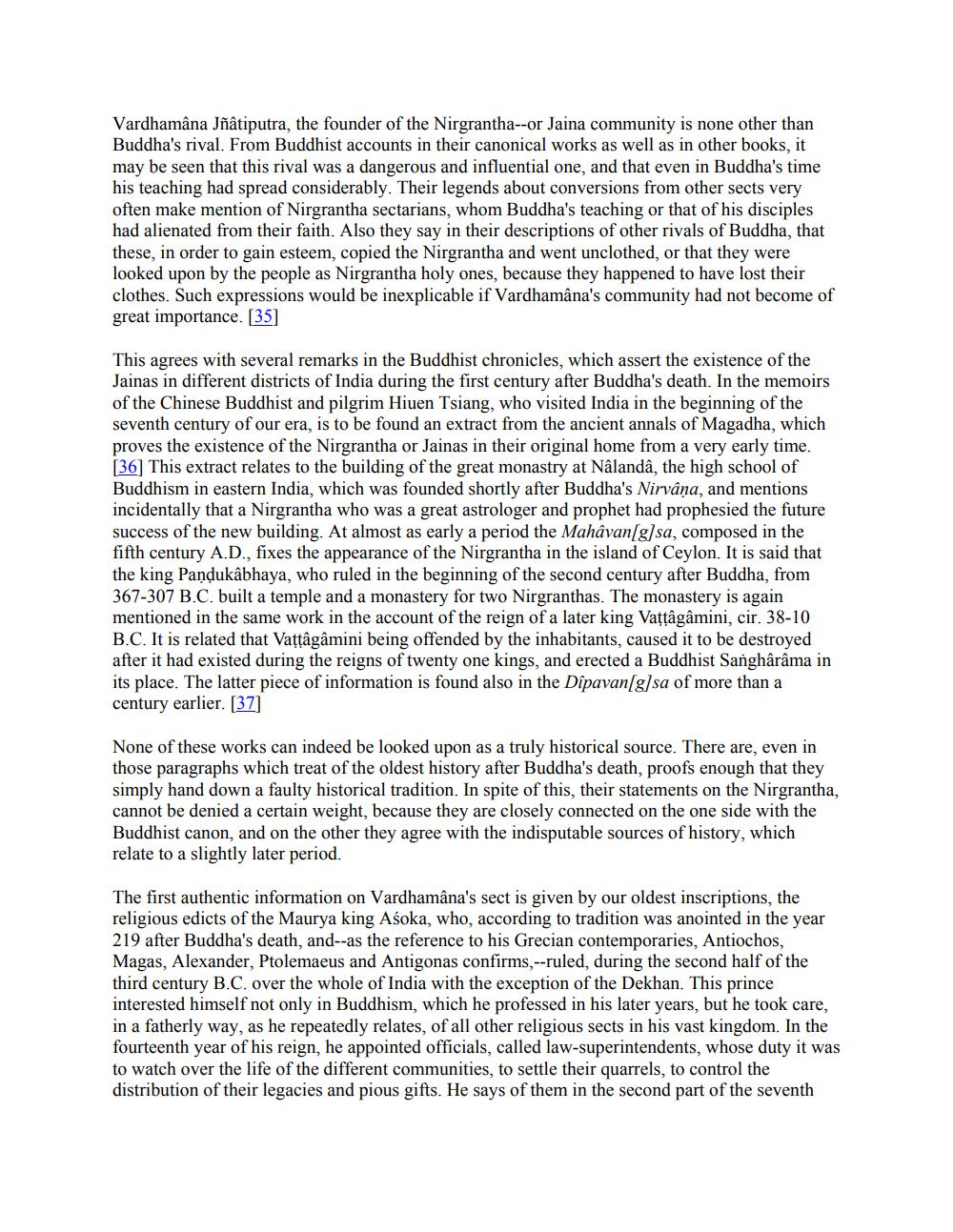________________
Vardhamâna Jñâtiputra, the founder of the Nirgrantha--or Jaina community is none other than Buddha's rival. From Buddhist accounts in their canonical works as well as in other books, it may be seen that this rival was a dangerous and influential one, and that even in Buddha's time his teaching had spread considerably. Their legends about conversions from other sects very often make mention of Nirgrantha sectarians, whom Buddha's teaching or that of his disciples had alienated from their faith. Also they say in their descriptions of other rivals of Buddha, that these, in order to gain esteem, copied the Nirgrantha and went unclothed, or that they were looked upon by the people as Nirgrantha holy ones, because they happened to have lost their clothes. Such expressions would be inexplicable if Vardhamâna's community had not become of great importance. [35]
This agrees with several remarks in the Buddhist chronicles, which assert the existence of the Jainas in different districts of India during the first century after Buddha's death. In the memoirs of the Chinese Buddhist and pilgrim Hiuen Tsiang, who visited India in the beginning of the seventh century of our era, is to be found an extract from the ancient annals of Magadha, which proves the existence of the Nirgrantha or Jainas in their original home from a very early time. [36] This extract relates to the building of the great monastry at Nalandâ, the high school of Buddhism in eastern India, which was founded shortly after Buddha's Nirvana, and mentions incidentally that a Nirgrantha who was a great astrologer and prophet had prophesied the future success of the new building. At almost as early a period the Mahâvan[g/sa, composed in the fifth century A.D., fixes the appearance of the Nirgrantha in the island of Ceylon. It is said that the king Pandukâbhaya, who ruled in the beginning of the second century after Buddha, from 367-307 B.C. built a temple and a monastery for two Nirgranthas. The monastery is again mentioned in the same work in the account of the reign of a later king Vattâgâmini, cir. 38-10 B.C. It is related that Vattâgâmini being offended by the inhabitants, caused it to be destroyed after it had existed during the reigns of twenty one kings, and erected a Buddhist Sangharama in its place. The latter piece of information is found also in the Dipavan[g/sa of more than a century earlier. [37]
None of these works can indeed be looked upon as a truly historical source. There are, even in those paragraphs which treat of the oldest history after Buddha's death, proofs enough that they simply hand down a faulty historical tradition. In spite of this, their statements on the Nirgrantha, cannot be denied a certain weight, because they are closely connected on the one side with the Buddhist canon, and on the other they agree with the indisputable sources of history, which relate to a slightly later period.
The first authentic information on Vardhamâna's sect is given by our oldest inscriptions, the religious edicts of the Maurya king Asoka, who, according to tradition was anointed in the year 219 after Buddha's death, and as the reference to his Grecian contemporaries, Antiochos, Magas, Alexander, Ptolemaeus and Antigonas confirms --ruled, during the second half of the third century B.C. over the whole of India with the exception of the Dekhan. This prince interested himself not only in Buddhism, which he professed in his later years, but he took care, in a fatherly way, as he repeatedly relates, of all other religious sects in his vast kingdom. In the fourteenth year of his reign, he appointed officials, called law-superintendents, whose duty it was to watch over the life of the different communities, to settle their quarrels, to control the distribution of their legacies and pious gifts. He says of them in the second part of the seventh




